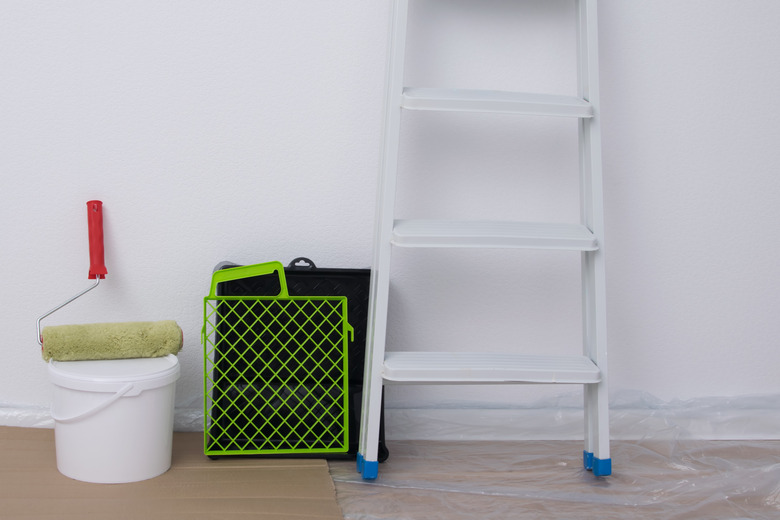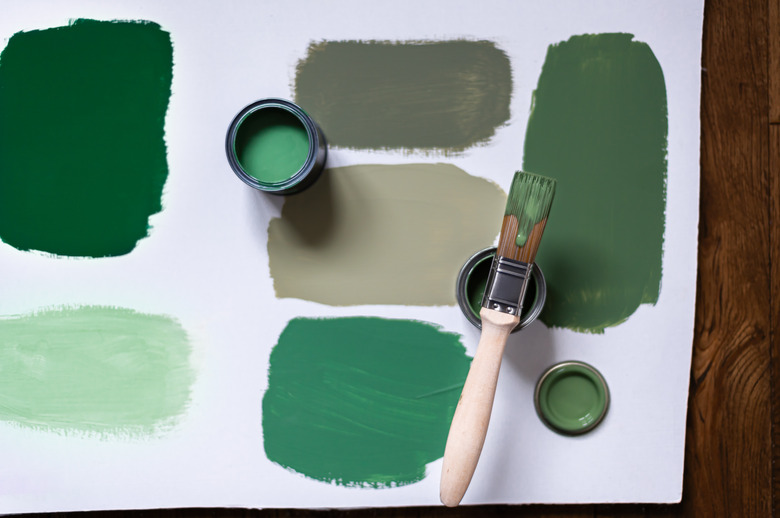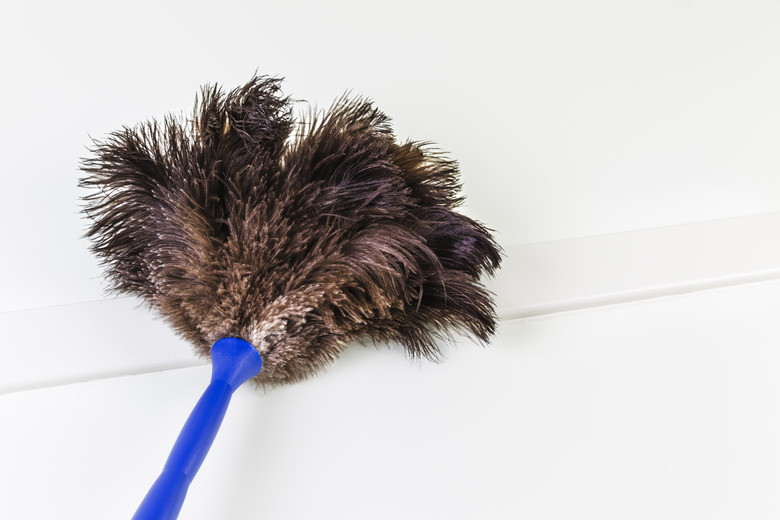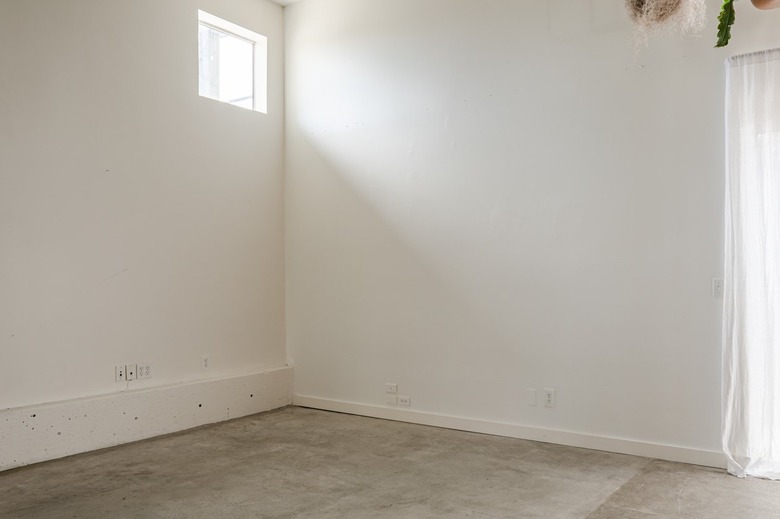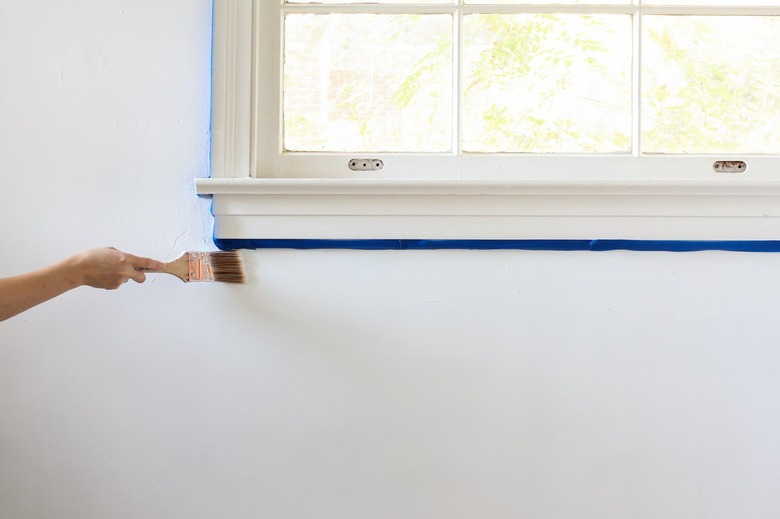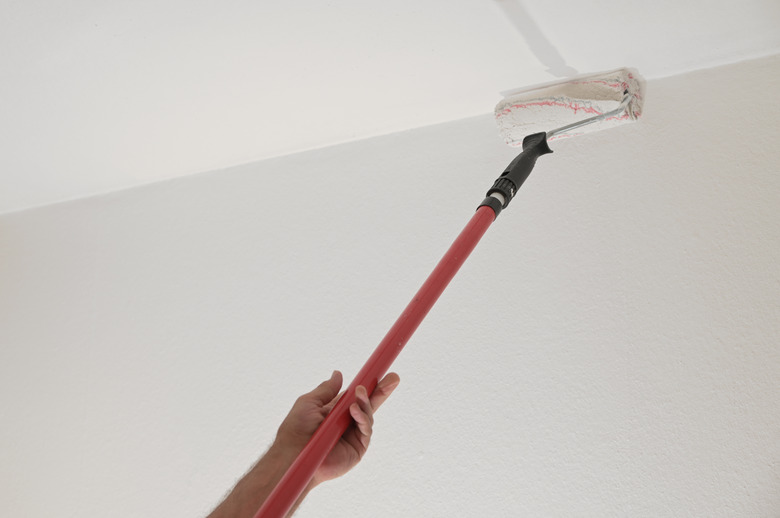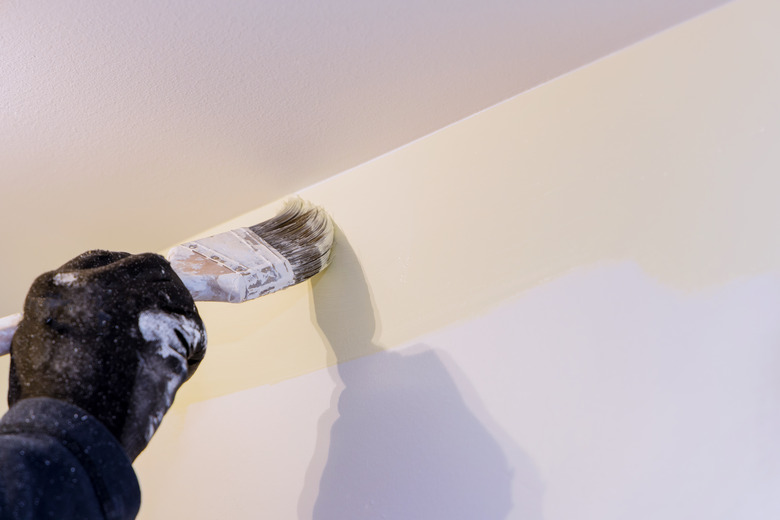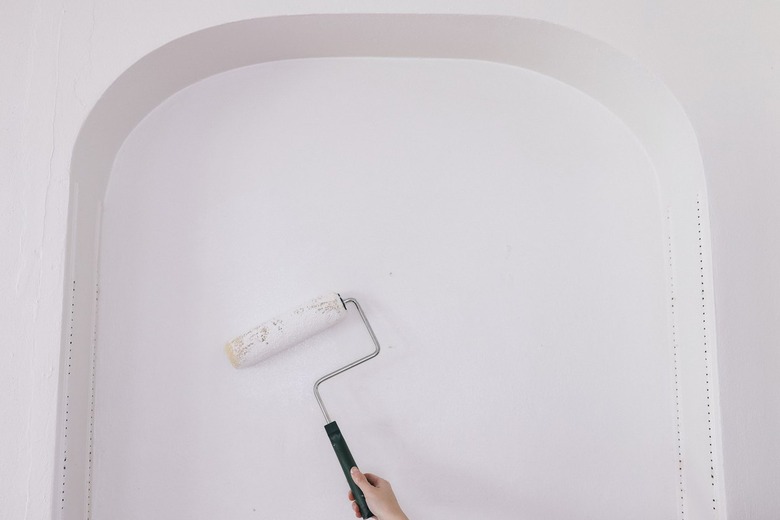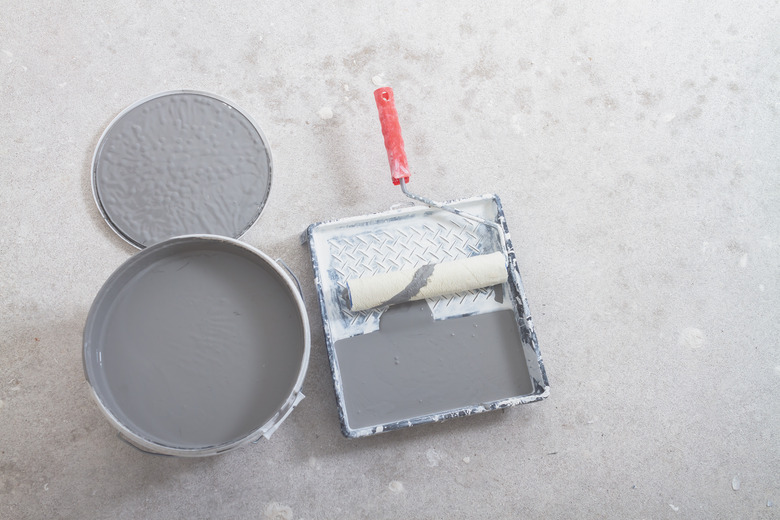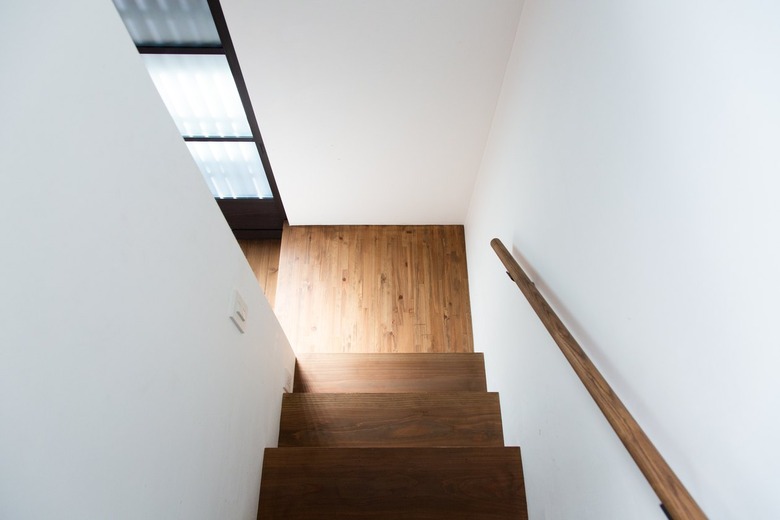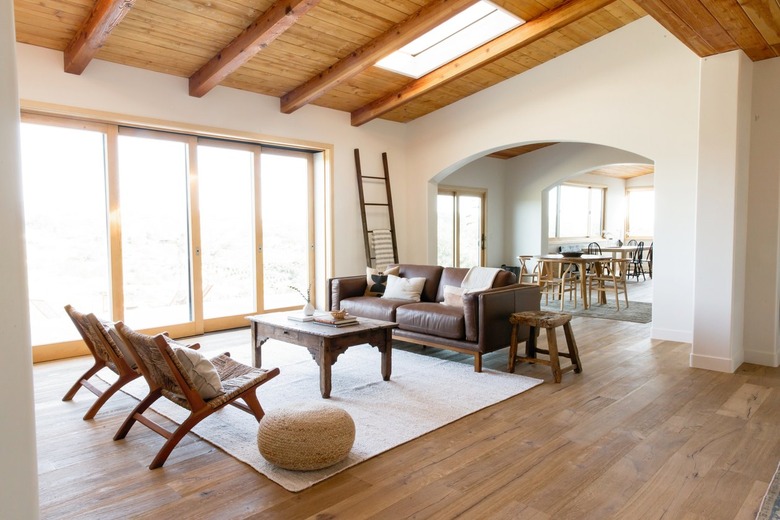11 DIY Tips For Painting Tall Walls
We may receive a commission on purchases made from links.
DIY painters rejoice! There are several tricks you can use to make painting tall walls a less daunting task. Yes, calling a professional painter is one of them, and it may be the best option if ladders freak you out or the idea of painting the wall has you completely frazzled. Before making that decision, however, take a look at a few ways you can make the job much more manageable.
1. Consider Safety
1. Consider Safety
It goes without saying, but here it is anyway: Always, always put safety first. If you're using a ladder, make sure it is securely positioned or have a helper hold it for you. Take care to never overextend yourself when on a ladder. Many people can comfortably reach about 3 feet on either side of a ladder, making for a 6-foot work area. If you can't, don't stretch. Get down and move the ladder, even if it starts to feel like you're doing so constantly.
If you buy or rent scaffolding for your project, make sure you assemble it correctly. Lock the wheels (if applicable) before climbing onto the scaffolding. On both ladders and scaffolding, be mindful of the weight limit and never stand on the top 3 rungs of an extension ladder. It's also important that you don't rush when painting tall walls. The process can feel slow, but doing things correctly and slowly will minimize the number of coats you need and prevent tall touch-ups later.
2. Choose the Right Paint Color
2. Choose the Right Paint Color
It may sound odd, but the height of your wall can actually affect your paint color choices. Often, tall walls are found in great rooms and other areas that are regularly bathed in natural light. A light wall color can add to the open and airy feeling, but it can also wash out and fade away in bright light. As such, many interior designers opt for and recommend somewhat darker colors on very tall walls.
The paint on a single tall wall can also look like a few different colors at once due to the large expanse of space. Make sure you like the paint color you choose equally well in bright light, muted light, and shadow. Different parts of the wall may exhibit all three conditions at one time.
3. Take Prep Work Seriously
3. Take Prep Work Seriously
The prep work required for painting is arguably the worst part of the project. It's time-consuming and generally not a lot of fun, but it's crucial for a good paint job, and it is particularly important when painting a tall wall where a simple touch-up may not be so simple.
Always clean your walls thoroughly before painting and remove any cobwebs or dust; otherwise, you will end up running your paintbrush through them and getting dirt in your paint. Prepping to paint a tall wall may also require a larger drop cloth. Your drips go further when you're up higher, so cover the floor with at least a 6-foot drop cloth.
4. Empty the Room
4. Empty the Room
When painting a room in your home, you can often get away with moving the furniture to the center of the room and covering it rather than removing it completely. That's great if it works, and it can save you a lot of elbow grease, but it may not be feasible in a taller room. When painting high walls, you're most likely going to be using an extension pole with your roller, and these can be hard to maneuver when it's time to reload it in the paint tray. To avoid inadvertently dripping paint onto your furniture or poking your paint roller through your TV, it's best to empty the room completely.
5. Use Care When Taping
5. Use Care When Taping
Even if you pride yourself on a steady hand and can normally skip the painter's tape, do not forgo it when painting tall walls. If you're on a ladder, your usually-steady hand may let you down. And if you're using a brush extension to avoid ladders, you will definitely get some paint where you don't want it if you don't tape.
As you tape, run a putty knife along the edge of the tape to create a good seal. Otherwise, the paint may wick around the tape and sneak into corners where the wall and ceiling meet. Use painter's tape when taping rather than masking tape. Masking tape often leaves behind a sticky residue and doesn't come off as cleanly as true painter's tape.
Tip
If you have a textured ceiling, run a standard (flat) screwdriver along the edge of the ceiling before you tape or paint. This makes a discrete but smooth surface around the edge of the room that is easier to both tape and cut in.
6. Use an Extended Paint Roller
6. Use an Extended Paint Roller
If ladders just aren't your thing, not to worry — you can paint a tall wall without one. Add an extension handle to your roller and roll the walls up and down to avoid climbing a ladder and having to bend down to reach the bottom of the wall. An extension pole takes a lot of the gymnastics out of painting and can really save your back in addition to helping you paint tall walls.
Cutting in a tall wall without a ladder gets a little trickier, but it is possible. You'll need to purchase a brush attachment for your extender pole. You can then place the brush on the end of your pole and use it to cut in around the ceiling. This painting technique is difficult to master, however, as you'll have a bit less control over the brush. But if you taped well, a few errant brush strokes shouldn't be a problem.
7. Cut In Deeply
7. Cut In Deeply
Ordinarily, cutting in (painting along the edges of the wall, ceiling, floor, and trim) requires no more than a brush stroke or two down the wall. When painting tall walls, however, thicker cut-ins can save you a lot of time and trips up and down the ladder. When cutting in, make sure you paint a good 6 to 8 inches down the wall. This way, you can reach your cut-in from the ground with your extension pole. It's a simple hack, but it saves lots of time.
Do the same with the baseboards and trim around windows and doors. Painting with a pole is helpful, but you may feel like you have less control and finesse. Giving yourself more wiggle room for your roller around the trim makes painting the walls with a roller easier and less nerve-wracking when you get close to the edges.
8. Get Good Coverage
8. Get Good Coverage
The fewer coats of paint you apply, the less time you spend running up and down the ladder. You don't want to apply the paint too thickly but do make sure you're applying an even coat and not leaving any skippers. The more thorough the coverage, the less likely you'll need a second coat.
If you're priming your walls, consider a tinted primer. Tinted primer helps you get better coverage and allows for fewer coats of paint. This is especially helpful when you're applying light paint over dark walls.
9. Maintain a Wet Edge
9. Maintain a Wet Edge
It's important that you work with a wet edge, not allowing the paint to dry out as you work. If the paint in one area dries while you're still painting the adjacent area, you may see a noticeable difference in the paint color where these areas meet, or your roller marks could show. To avoid this issue, work on one wall at a time. Cut in just one wall and then roll the same wall right away. Do not cut in all the way around the room and then start rolling.
If you paint slowly, you can help maintain a wet edge by adding a paint extender to your paint. This chemical extends the drying time of paint, giving you more time to work before it dries. It also helps smooth out the paint to avoid brush strokes.
10. Paint Stairwells Carefully
10. Paint Stairwells Carefully
Painting tall walls over a set of stairs is a potentially dangerous job. When doing it, you really need a multiposition ladder or a ladder aid that can support a ladder on stairs. The right ladder makes the job easy. The wrong one makes it dangerous. Don't try to work around getting the proper ladder or rig up some homemade painting contraption.
You can use your roller extender to try to avoid using a ladder, but be careful and try not to reach too far into the stairwell. Even if you've been painting as a DIY project up until this point, there is no shame in leaving the stairwell to a pro who already has the right equipment and know-how.
11. Take Regular Breaks
11. Take Regular Breaks
Painting is a fairly physical activity, and painting tall walls means doing a lot of the work over your head. Even with a roller extension, you're likely to notice your arms and shoulders getting tired quickly. You should also expect sore shoulders and a stiff neck when cutting in using a brush attachment, as this is slow work.
To keep your painting project going, it's perfectly fine to work slowly and take frequent breaks if you need them. If you don't listen to your body, you could get hurt or become sore enough that you won't be able to keep painting tomorrow.

